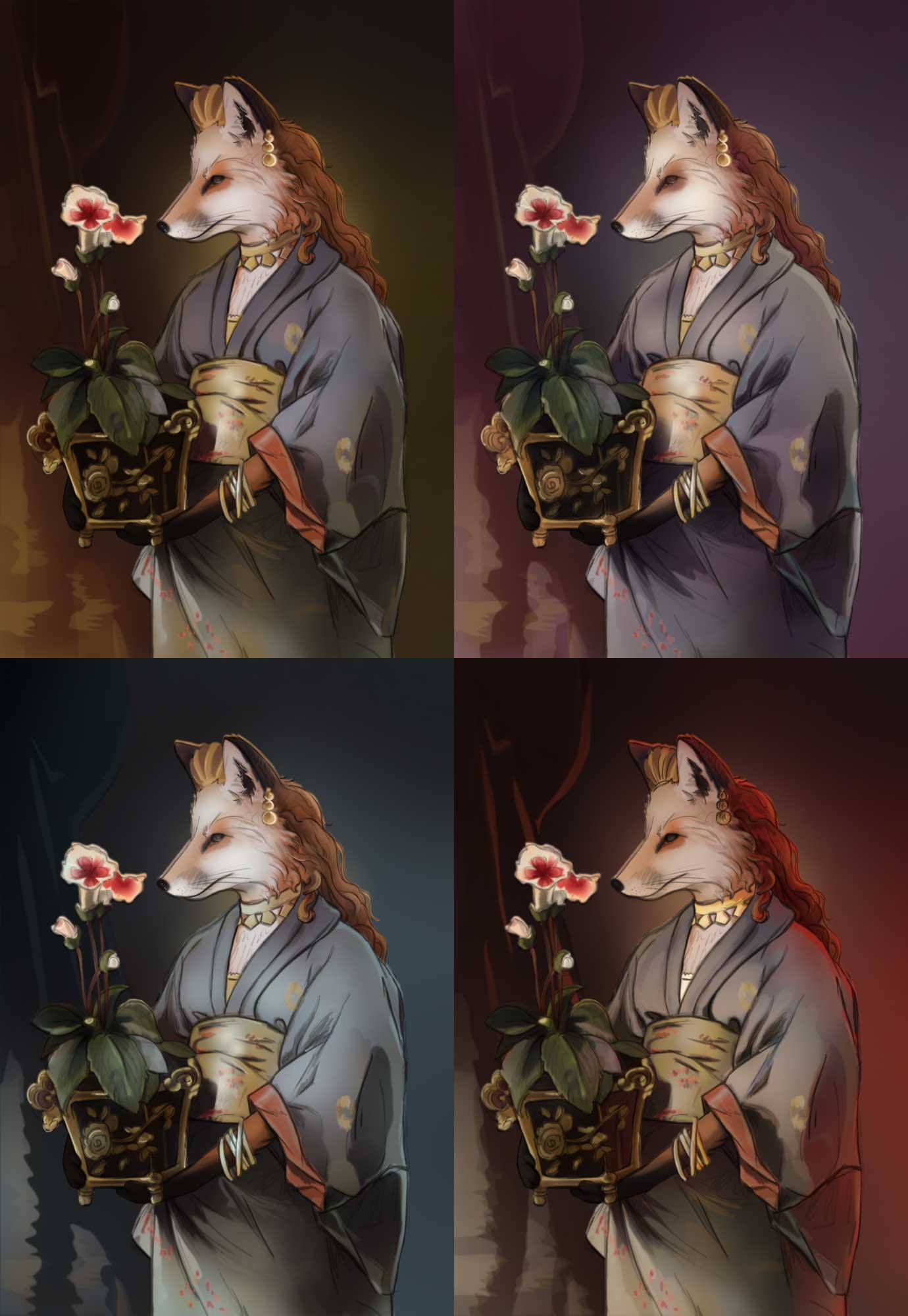Fox in Kimono Project
This month has been filled with learning new things. At the beginning of the month I joined The Magic Box, an online art course and community that has proved to be an excellent resource not only with the courses but the attention and true critiques of my work in progress from fellow classmates. Hers is my first homework assignment. The purpose was to practice a new technique of coloring, creating forms with color and not brushes, and to create color comps before beginning your art project, planning out to minimize the problems later. We were asked to start by selecting a master painting and pair it with an animal. Here is my "Fox in Kimono".
My reference, “Yamatori” by Alfred Stevens, and very first sketch.
After receiving feedback I modified the paw, gave her hair and then I began the process of coloring. The assignment was to create 4 “color comps”. Working with your design before diving in with a brush allows you to plan and process your idea so that the finished work is much more intentional and thought out. It’s something that I intend to do much more of in the future.
Top left is the original colors from my reference painting and the following three were inspired from movies or photographs. The first color pallet (top right) from a photo of a purplish ocean at sunset, bottom left was from the movie “Oblivion” and the one beside it, taken from “Memoirs of a Geisha”.
Which color is your favorite?
Along with techniques to creating art I've been gathering a lot of ideas about creating, thoughts on what it means to be an artist. Here is what I've been learning, a few tips and thoughts.
Creating art takes dedication. The craft isn't something I can take casually anymore, not if I truly want to improve. It's more then passion or creativity. It's practice and perseverance. A stubbornness to keep going and never stop.
Value studies from masterworks.
Create for myself. I recently met with a souvenir shop owner to see if they would be interested in selling some of my photography. This was a first for me since moving here to Japan. We spoke and I quickly gathered that my initial impression was incorrect and that they were not looking for another photographer to display work of. I was frustrated as I could see that my work was different than the current photographer displayed there, and frustrated to hear that my artistic photographs didn't sell well. She suggested that I "get my camera out" and start shooting infrared photography of the area. It was then that I had a choice, to cater to her specific clients and create new work or to keep creating for myself and you, my audience. It wasn't an easy choice and one that we all have to make. My personality is one that I feel an immediate need to please or cater to someone else's needs and it drains me. Saying "no" and sticking to what I've found truly makes me happy, what energizes me was a conscious choice. That doesn't mean that in time I may pick up the D70 and shoot infrared, but it does mean that when I do it will be on my own time and with my own vision.
Be accepting of critique. This follows right along with my above example. It's very healthy to learn to receive, and give, constructive criticism without getting your feelings hurt. I also think it takes a bit of talent to sort through the mediocre comments and accept some of the hard truths that maybe your work really isn't "there" yet. It is also just as important, when starting out, to find a safe and trusted environment to receive such critiques, a classroom environment or place like Chris Oatley's Magic Box community, for example. Don't give critique if it isn't asked for.Enough said. Don't do it.
References are essential to learning. I used to think that looking at several images to see what an unfamiliar animal or environment looked like felt a bit like cheating. Somehow I was supposed to conjure up these things without really knowing or understanding what they were and how they worked. I was so wrong. I love using references when I work and knowing that other, very very good artists and professionals use them as well has really allowed me to value references for what they are, tools to train and create. When I refer to references I'm referring to photographs, life and yes, even other artist's work. I think Will's video describes my thoughts perfectly.
My references for my “Fox in a Kimono” project.
I undervalue my sketchbook. I have always loved working digitally. Since high school I have been honing my painting and manipulation skills through programs like Photoshop, Illustrator, Corel Painter and Paint Tool Sail. And with all of these I am now very comfortable sketching in them digitally. But something changed when I finished college. I don't doodle anymore. The moment where a pencil or pen is on paper, for me, is very little. A physical sketchbook is your place to let your mind wander when you're away from the computer, to create yes, but to put down your ideas, good and mostly bad. It's a testing ground for all your bad ideas. Which brings me to my final point...
A personal project, basic value studies & composition from photographs.
Bad drawings are ok. In fact they're good. You don't have to show the world them. They're yours to burn or keep and laugh about down the road. I didn't know this or take it to heart and there was always pressure to finish or correct a drawing. Leave it be and move on.
What have you learned this week?








